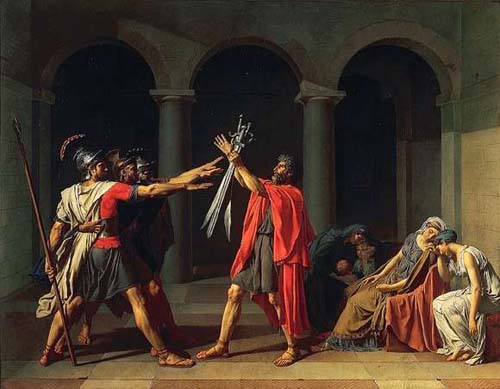7. The Eighteenth Century Synopsis art 162 honors
In art, as in life, the Eighteenth Century was a century of transition. The Late Baroque styles which had evolved into the artifice of the Rococo were eventually abandoned in the face of a new world outlook as the "Age of Enlightenment" opened up throughout Western realms. The previous two centuries' discovery and expansion of growing colonies around the globe had brought wealth and power to the established European nations; this is turn helped spark the Industrial Revolution, which, fueled by new discoveries in science and new inventions, brought about vast societal changes. Philosophy simultaneously advocated both the efficiacy of objective scientific reason and the primacy of subjective feelings. As a result, Neoclassicism and Romanticism paralleled each other into 19th century some times in oppostion, and some times as a complement, to the other.
- DJB

Napoleon Crossing the Alps at St. Bernard - Jacques Louis
David
Age of Enlightenment 1750 - 1785
Neoclassicism 1780 - 1820
Romantic Era 1750 - 1850
(Rococo c. 1700 - 1750)
TERMS
Voltaire - Pen name of Francois Marie Arouet (1694-1778) (R-1065) - caustic
French iconoclast, satirist, writer, and philosopher
Pompeii & Herculaneum - ancient Roman empire
cities near Naples destroyed by Vesuvius eruption in 79 CE, excavations
begun in 18th century
Rousseau - Jean Jacques Rosseeau (1712-1778) Swiss-born French philosopher,
author, political theorist, and composer. (R-879)
“social protest art” - art, like Goya's Third of May 1808,
that made a pointed commentary against injustices
Aquatint - printing technique that produces
prints with tonal qualities
The Eighteenth Century - period between 1700
and 1850 (for art historical purposes), the period bridging the Late Baroque
and the beginnings of the Modern era
Enlightenment - historical period from the late
Seventeenth to the mid-Eighteenth Century where advances in knowlege and
discoveries in science were accompanied by corresponding new directions
in philosophical thought, bringing forth belief that a combination of
reason and science would free humanity from its bonds of imperfection
and inhumanism
Odalisque - member of a Turkish harem
Marat - Jean Paul Marat (1743-1793) Swiss-born French politician and physician...
Assassinated in his bath by Charlotte Corday on July 13, 1793 (R-633),
an event immortalized by David in his painting
Death of Marat (1793).
Black paintings - refers to Goya's privately-displayed
paintings of a pyschologically unsettling and macabre nature.
Age of Enlightenment 1750 - 1785
William Hogarth,1697 - 1764
Marriage a La Mode, 1745
Thomas Gainsborough, 1727 - 88
Mary Countess Howe, c. 1765
Angelica Kauffmann — 1741 - 1807
Cornelia Presenting Her Children as Her Treasures, 1785
Elisabeth Louis Vigee-LeBrun, 1755 - 1842
LeBrun and Daughter, 1785
Neoclassicism 1780 -1820
Jacques-Louis David 1748 - 1825

Oath of the Horatii 1784
The Death of Marat, 1793
Thomas Jefferson 1743 - 1826
Monticello, 1770 - 1806
Jean-Auguste Dominique Ingres 1780 - 1867
Apotheosis of Homer, 1827
Grande Odalisque, 1814
ROMANTICISM 1800 - 1850
William Blake, 1757 - 1827
Ancient of Days, 1794
Francisco Goya 1746 - 1828
Family of Charles IV, 1800
The Third of May 1808, Oil on canvas 1814
Saturn Devouring His Child, 1819 - 23
The Sleep of Reason Produres Monsters, 1798
Theodore Gericault, 1791 - 1824
Raft of the Medusa, Oil on canvas 12’ x 23’ 1818-19
Insane Woman, Oil on canvas, 2’ 4” x 1’ 9” c.
1822-23
Eugene Delacroix, 1798 - 1863
The Death of Sardanapalus, Oil on canvas, 12’ x 16’ 1826
Liberty Leading the People, Oil on canvas, 8’6” x 10’S”
1830
Caspar David Friedrich, 1774 - 1840
Cloister Graveyard in the Snow, Oil on canvas, 3’ll” x 5’lO”
1810
Polar Sea, 1824
John Constable, 1776 - 1837
The Hay Wain, Oil on canvas, 4’3” x 6’2’ 1821
Joseph Mallord William Turner, 1775 - 1851
The Slave Ship, Oil on canvas, 2’ll” x 4’ 1840
Rain, Steam, and Speed, 1844
Winslow Homer, 1836 - 1910
Boys in a Pasture, 1834
Sir Joseph Paxton, 1801 - 1865
Crystal Palace, 1850 - 51
Links:
Jaques Louis David
http://www.asds.org/2001/jaques.htm
Monticello: The Home of Thomas Jefferson
http://www.monticello.org/housegardenplant/index.html
The William Blake Archive
http://www.blakearchive.org
Notes:
Neoclassicism Qualities (A-68):
Values: Order, solemnity
Tone: Calm, rational
Subjects: Greek and Roman history, mythology
Technique: Stressed drawing with lines, not color; no trace of brushstrokes
Role of Art: morally uplifting, inspirational
Founder: David
Romanticism Qualities (A-76):
Values: Intuition, Emotion, Imagination
Inspiration: Medieval and Baroque era, Middle and Far East
Tone: subjective, spontaneous, nonconformist
Color: Unrestrained, deep, rich shades
Subject: Legends, exotica, nature, violence
Genres: Narratives of heroic struggle, landscapes, wild animals
Technique: Quick brushstrokes, strong light-and-shade contasts
Compostion: Use of diagonal